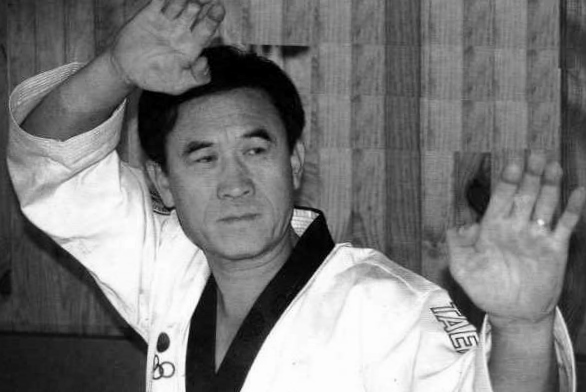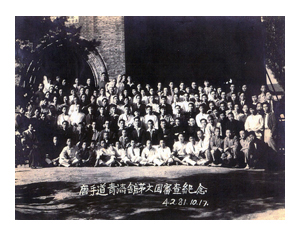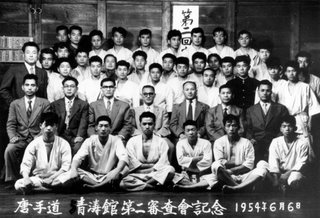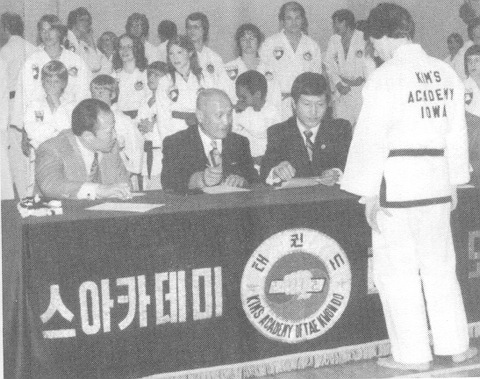HISTOIRE DU TAEKWONDO

Maître Kim Yong Ho (1997)
Dès 1944 est créée l’Académie Chung Do Kwan,(1) première Kwan (école) de Tae Kwon Do dans le monde, située a Yung Chun Séoul. Chung Do Kwan fut fondée par le Grand Maitre Lee Won Kuk, suivi du Maitre Song Duk Sung. Par la suite, de nombreux autres Kwan furent créées et de nombreux Dojang ont ouvert. Le nom de l’Académie « Chung Do Kwan » se traduit littéralement par « l’ école des vagues bleues » en caractère chinois cela signifie « la droiture ». Les vagues symbolisent ici une source d’énergie et de connaissance infinie, créant dès lors le système du « principe de l’eau ». C’est pendant cette période que le Taekwondo fut déclaré Art Martial National de Corée.
Après 1944, beaucoup de Kwan virent le jour. Le Président Rhee, président du gouvernement de la Corée du Sud, décréta que tous les soldats devaient pratiquer les Arts Martiaux Militaires. Le 11 avril 1955, un comité spécial composé des maîtres dirigeants et d’historiens s’est réuni pour discuter une proposition d’Appellation Nationale. C’est la suggestion du Général Choi Hong Hi qui est maintenant l’appellation moderne : le terme Tae kwon do fut adopté, principalement parce qu’il était proche de l’appellation originale de « Taekkyon », Tae signifiant « Frapper avec le pied », Kwon « frapper avec le poing » et Do « la voie ».. Chung Do Kwan fut adopté rapidement comme « académie » de référence pour l’armée coréenne, en raison de sa discipline, ses entraînements rigoureux et la grande expertise de ses instructeurs qui possédaient l’habileté en technique et en combat. Ces Maîtres du Taekwondo entraînèrent donc la majeure partie des unités et, en 1953, la section militaire spéciale de l’école Chung Do Kwan, appelée «Oh Do Kwan ». Cette section fut attribuée au Général Choi Hong Hi et au Commandant Nam Tae Hi, des forces spéciales, assisté de Han Cha Kyo. Ils étaient tous deux hauts gradés de l’Académie de Taekwondo Chung Do Kwan. C’est la naissance de la Division d’Élite de l’armée Coréenne. A partir de 1957, l’Académie du Chung Do Kwan fut dirigée par le grand maître Uhm Woon Kyu, Président de la World Chung Do Kwan, Président de l’Association de Taekwondo de Séoul, Premier Secrétaire Général de l’Association Coréenne de Taekwondo (KTA), Vice-président de la Fédération Mondiale de Taekwondo (WTF), Instructeur en Chef de l’Académie Militaire et Premier Examinateur pour les Dan Militaires. A partir de 1959, de nombreux instructeurs de Taekwondo du Chung Do Kwan furent envoyés à la guerre du Vietnam. Le grand maître Park Hae Man, élève direct de grand maître Uhm Woon Kyu lui succéda à la tête du Chung Do Kwan. Au début des années 1960, il n’y avait pas moins de 17 Kwan répartis en Corée. En 1972, le Président Chung Hee Park souhaite que le Taekwondo devienne le sport national de la Corée. En 1973 la Fédération Mondiale de Taekwondo (WTF) voit le jour et est considérée comme le Corps National et Mondial de l’Art Martial National Coréen. Le Grand Maitre Uhm Woon Kyu fut à la source du Taekwondo moderne, responsable de la formulation des règles du Taekwondo sportif. En outre, il est considéré par les milliers de pratiquants qu’il a entraînés comme le leader du Taekwondo en Corée et, par extension, dans le monde entier. Il a consacré à peu près toute sa vie au développement du Taekwondo, il fut également Président du Kukkiwon (centre mondial du taekwondo). Les Experts d’origine Coréenne enseignant le TaekwonDo en France depuis 1969 sont majoritairement issus de l’académie de Taekwondo Chung Do Kwan. Parmis eux peuvent être cités les maîtres Lee Kwan Young et Kim Yong Ho.
Les principales académies de Taekwondo aujourd’hui se nomment :
ChungDo Kwan, Moo Duk Kwan, Yun Moo Kwan, Chang Moo Kwan, Oh Do Kwan, Ji Do Kwan, Chi Do Kwan, Song Moo Kwan, Kang Duk Kwan ….
Depuis février 2011, le grand master Kim Yong Ho, fondateur du Tae Kwon Mu Do (2), a été nommé à la tête du Chung Do Kwan.
- (1) Chung-Do-Kwan : dit « Ecole des vagues bleues ». Sa Méthode fut créée à Séoul en 1944 par le grand Maître Won Kook Lee et qui est la base du Taekwondo
- (2) Le Tae Kwon Mu Do a été créé en 1997 pour réhabiliter les valeurs « martiales » du Tae Kwon Do historique
-

Grand Master Lee Won Kuk
CHUNG DO KWAN was officially formed in 1944 by Grand Master Won Kuk Lee (April 13th 1907 – February 2nd 2003). The name Chung Do literally translates to ‘The Way of the Blue Wave’, Kwan translates to simply, club. According to sources Master Lee came up with the name whilst sitting on a beach watching the ocean. The name symbolises calmness and control until disturbed at which time destructive power is unleashed. The word DO (probably the most important in Taekwondo) means correct way both in teachings and life. Many more kwans were developed after 1944 however, Chung Do Kwan is the oldest. Chung Do Kwan was and is respected for producing the most technical students and for being the most disciplined. Grand Master Lee was concerned that many Koreans associated martial arts with organized crime, so he would not accept troublemakers or criminals into the Chung Do Kwan, and enforced a strict code of conduct on his students. From the beginning: Grandmaster Lee, Won Kuk was born April 13, 1907. As a young man he always had a love for the martial arts however, due to the Japanese occupation of Korea, it was forbidden to teach or study any martial art. Outside of Korea though was a different story and Grand Master Lee, started his martial training whilst studying at the Central University law School in Japan. Whilst he was there during the 1920’s he studied what is now known as Shotokan Karate-do with Gichin Funakoshi, the founder of the Shotokan system. After graduating from college, Lee settled in Japan and although experimented in other martial arts, Shotokan remained his primary focus, and he eventually reached the rank of fourth degree black belt (at the time, the highest rank was fifth degree, which only Funakoshi himself held). - After achieving his black belt, Grand Master Lee decided to return to Korea and show his people the martial arts he had learnt under the name Tang Soo Do later to become known as Tae Kwon Do. “I practiced Tang Soo Do and came to realize this type of skill was very important to have. I became aware that our Korean national history and legacy of martial arts were being kept from us. I felt very bad about this.”(Master Lee) In 1944 Grand Master Lee was forced to leave Japan due to the ongoing American bombardment of Toyko. He returned back to Seoul and applied to the occupation government to be permitted to teach the martial arts. The Japanese had allowed Koreans to study arts such as judo and kendo under Japanese instructors beginning in 1943, but they were cautious about approving a school led by a Korean, and Lee was refused twice. However the third time, he was approved with the help of the Japanese Governor General Abe. It was a dark time for Grand Master Lee as he was truly regretful for having a relationship General Abe. Though it may not have been the way Grand Master Lee would have liked it, he taught the art of Tang Soo Do for the first time in Korea at the Yung Shin School Gymnasium in Sa De Mun, Seoul. This was the first of many dojangs to be opened. Grand Master Lee was a popular instructor, and the Chung Do Kwan grew rapidly. However, his long residence in Japan and the fact that he had run a Japanese-sanctioned organisation during the war caused many to view him with suspicion.
-

-
In 1945, he was charged with being a Japanese collaborator. Although was acquitted, and his popularity remained relatively unaffected, the allegations of collaboration would be used against him later. By the late 1940s, the Chung Do Kwan had over 5,000 students and because his dojang was located not far from the Korean National Police headquarters, he had attracted many police officers as students. His popularity as an instructor and his strong ties with the police caught the attention of Yi Seungman (South Korea’s first post war president), who offered Grand Master Lee the position of Minister of Interior. Lee refused, feeling this was an attempt to force him to approve the party in power, and fearing his students would be pressed into service as “muscle” for the regime.
- In retaliation, President Yi brought back the old charges of being a Japanese collaborator. He was declared an enemy of the state and imprisoned. In 1950 Lee was released and fled to Japan, where he lived as a political refugee. When he left Korea, he appointed his senior student Yoo Ung Jun to succeed him as Kwan Jang of the Chung Do Kwan. Yoo instead became a supporter of North Korea and eventually the position went to Son Duk Sung. Son was succeeded as President of the Chung Do Kwan by Uhm Woon Kyu in 1959. (Grand Master Uhm continues as the Chung Do Kwan President to this day and also serves as President of the Kukkiwon (World Taekwondo Headquarters). In 1976, Grand Master Lee immigrated to the United States, where he continued to teach taekwondo and was eventually promoted to tenth degree black belt. In an era when millions of people practice taekwondo, it’s easy to forget that this martial art would not have evolved to where it is without the effort of a small group of courageous and determined pioneers. Grand Master Lee Won Kuk left a huge legacy. Many of his students went on to found their own kwans in Korea. Some, like Jhoon Rhee, were directly responsible for bringing taekwondo to other countries. Lee’s students were major players in the founding of both the World Taekwondo Federation and the International Taekwon-Do Federation. In the United States, such major organizations as the American Taekwondo Association and the United States Chung Do Kwan Association have direct roots in the Chung Do Kwan. From the founding of that one small training hall in 1944, Won Kuk Lee’s influence has extended to literally millions of taekwondo practitioners, making him a key figure in the art’s establishment and growth.
-

-
Grand master Uhm Woon Kyu was the fourth Chung Do Kwan Kwan Jang, after Lee Won Kuk, Yoo Ung Jun and Son Duk Sung. In February 2011 he resigned from his role of leader of the Chung Do Kwan and President of the Kukkiwon, and appointed his student Master Kim Yong Ho, 9th Dan, the title of Kwan Jang. Whilst training Grand Master Uhm’s nickname was “Sliding Side Kick God,” due to his unmatched ability with that technique. Reportedly, he could kick an opponent from ten feet away using it. Master Uhm is one of the pioneers of modern day Taekwondo and helped devise the current rules governing Taekwondo free sparring. He was also Special Instructor for the South Korean Military. He also played a large part in the formation and development of the Korea Taekwondo Association (KTA), the World Taekwondo Federation and the Kukkiwon (World Taekwondo Headquarters). -

-
As one of Grand Master Lee Won Kuk’s original and first students, Master Uhm remains a link to the original Chung Do Kwan. As Head of the Chung Do Kwan and President of the Kukkiwon, he has spent decades ensuring that Taekwondo is taught correctly making it one of the most celebrated martial arts. Master Uhm is one of the most important Taekwondo figures in Korea, and one of the most important in the world today.
-
In May 2011 he will visit England for the first time with Grand Master Kim Yong Ho, to attend an International Taekwondo Festival, in honour of the Chung Do Kwan UK. Grand Master Kim Yong Ho, 9th Dan, has been appointed President of the worldwide CHUNGDOKWAN in Korea. He was awarded this top position by his instructor Grand Master Uhm who will step aside from the position. It makes Grand Master Kim the fifth Head of the Chungdokwan since Grand Master Lee Won Kuk founded it in 1944. Master Kim will work hard to try and bring together the worldwide Chung Do Kwan. In May 2011, Grand Master Uhm and Master Kim will be visiting the UK and attending an International Taekwondo festival in Blackpool, England. This is to celebrate the UK Chung Do Kwan coming together. It will be the first time Grand Master Uhm, who’s in his 80’s has visited the UK. Grand Master Kim Yong Ho will be teaching a seminar at the Festival as well as three seminars across the country in February 2011.
Founders
Chung Do Kwan – founded 1944 by Won Kuk Lee
Moo Duk Kwan – founded 1945 by Hwang Kee
Chang Moo Kwan – founded 1946 by In Yoon Byuna
Song Moo Kwan – founded 1953 by Byung Chik Ro
Ji Do Kwan – founded 1953 by Gae Buynga
